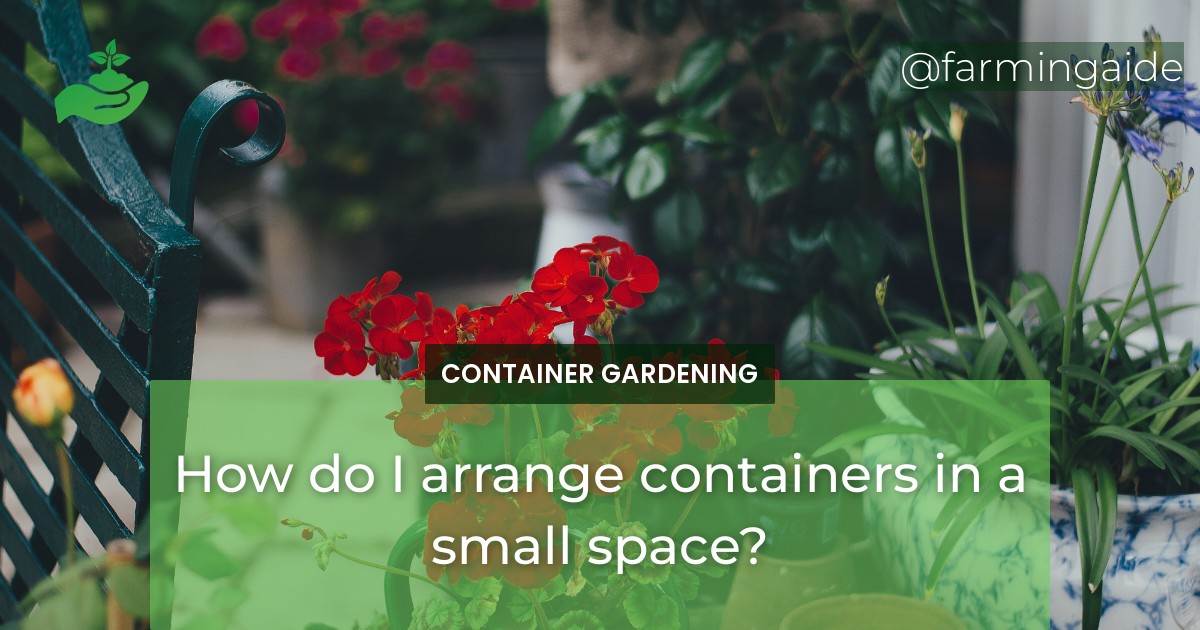Arranging containers in a small space can be challenging, but with proper planning and organization, it can be done in a way that maximizes space utilization and enhances the beauty of your garden. Container gardening is an excellent option for those with limited space, and it offers many benefits, including flexibility, mobility, and accessibility. In this article, we’ll explore how to arrange containers in a small space, from planning and selecting containers and plants to arranging and maintaining your garden. We’ll also look at tips for maximizing yield and preserving your harvest. By the end of this article, you’ll have all the information you need to create a beautiful and productive container garden in a small space.
Maximizing Space Utilization in Small Container Gardens
Planning Your Container Garden
Assessing Your Space
The first step in arranging containers in a small space is to assess your space. Look at your available space and consider factors such as sunlight, shade, wind, and water availability. Determine the size of your space and the number of containers you can accommodate. This will help you choose the right containers and plants for your garden.
Choosing the Right Containers
Choose containers that are appropriate for your space, style, and plants. Consider the material, size, shape, and color of the containers. Ceramic, terracotta, and concrete containers are great for adding texture and style, but they can be heavy and difficult to move. Plastic and fiberglass containers are lightweight and easy to move, but they may not be as visually appealing. Choose containers that are large enough to accommodate your plants’ roots, but not so large that they overpower your space. It’s also essential to choose containers with adequate drainage to prevent root rot and other diseases.
Selecting Plants for Small Spaces
Choosing the right plants is crucial for a successful container garden. Consider the amount of sunlight, water, and space your plants need. Select plants that are appropriate for your environment and container size. Some plants, such as herbs, lettuce, and strawberries, are well-suited for container gardening because they require minimal space and can thrive in small containers. Other plants, such as tomatoes, peppers, and cucumbers, may require more space and support to grow.
Arranging Your Containers
Vertical Gardening Techniques
Vertical gardening is an excellent way to maximize space utilization in small container gardens. You can use walls, trellises, and stakes to grow your plants vertically. This technique is especially useful for plants that climb, such as tomatoes, beans, and cucumbers. You can also use hanging baskets to grow trailing plants such as strawberries and petunias.
Grouping Containers
Grouping containers is an effective way to create a cohesive and visually appealing garden arrangement. Group plants with similar sunlight, water, and soil requirements. You can also use groupings to create different zones in your garden, such as a herb garden, a vegetable garden, and a flower garden.
Using Shelving and Stands
Shelving and stands are great for adding height and dimension to your garden. You can use them to display your plants in a visually appealing way and to maximize space utilization. Choose shelving and stands that are sturdy and can support the weight of your containers.
Maintaining Your Container Garden
Watering and Fertilizing
Proper watering and fertilizing are essential for a healthy container garden. Water your plants regularly, and make sure the soil is moist but not waterlogged. Fertilize your plants with a balanced fertilizer every two to four weeks to ensure they have the nutrients they need to thrive.
Pruning and Deadheading
Pruning and deadheading are essential for maintaining healthy plants and promoting growth. Prune your plants to remove dead or diseased branches and to shape them. Deadhead your plants to remove spent flowers and encourage new growth.
Dealing with Pests and Diseases
Pests and diseases can quickly spread in a container garden. Monitor your plants regularly for signs of pests or diseases, such as yellowing leaves, wilting, or spots on the leaves. Treat them promptly with organic or chemical treatments to prevent them from spreading.
Harvesting Your Container Garden
Knowing When to Harvest
Knowing when to harvest your plants is critical for maximizing yield and flavor. Harvest your plants when they are at their peak ripeness and flavor. This will vary depending on the plant and the variety. For example, tomatoes are typically harvested when they are red and firm, while strawberries are harvested when they are bright red and plump.
Maximizing Yield
Maximizing yield requires proper care and maintenance of your plants. Water and fertilize your plants regularly, and prune them to encourage growth. You can also use techniques such as succession planting, companion planting, and intercropping to maximize yield in a small space.
Preserving Your Harvest
Preserving your harvest is an excellent way to enjoy your garden’s bounty all year round. You can freeze, can, or dry your fruits and vegetables to preserve them. Herbs can be dried or frozen for later use. You can also make sauces, jams, and other preserves with your harvest.
Conclusion
Arranging containers in a small space requires careful planning, organization, and maintenance. By following the tips and techniques outlined in this article, you can create a beautiful and productive container garden that maximizes space utilization and enhances the beauty of your space. Remember to assess your space, choose the right containers and plants, arrange your containers to maximize space utilization, and maintain your garden with proper care and attention. Happy gardening!


